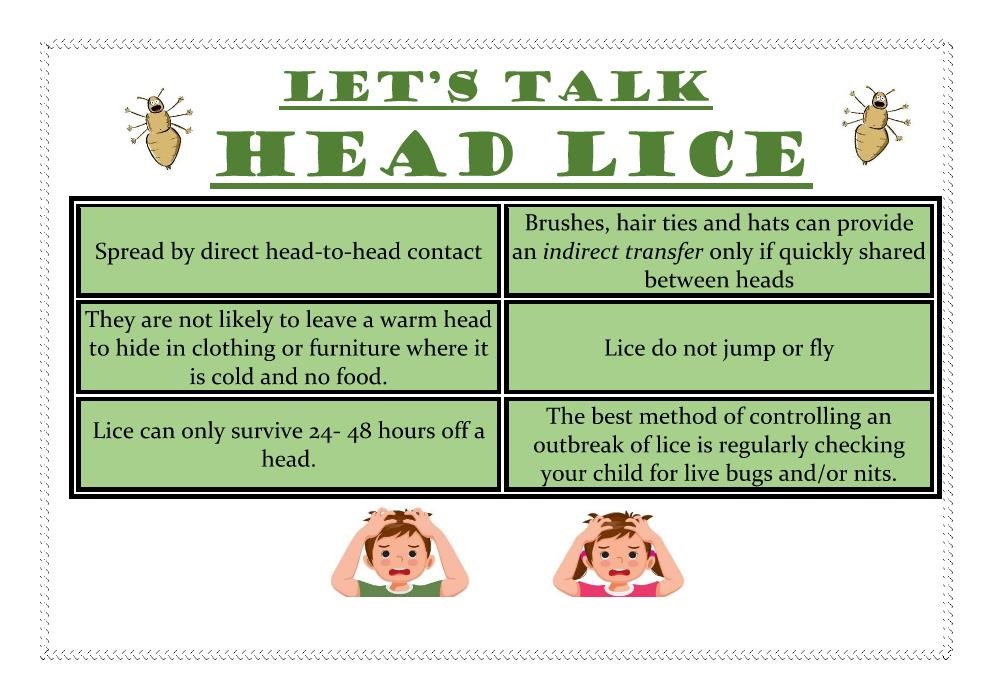
WHAT ARE HEAD LICE?
- Head lice are tiny, wingless, grayish-tan insects that live and breed in human hair. Lice cannot jump or fly, as they have no wings or hind legs. They are about the size of a sesame seed with six claws that attach to the hair shaft. The eggs, called nits, are easier to see than the lice themselves and are usually found attached to hair shafts close to the scalp behind the ears and on the back of the head.
- There are three forms of lice: the nit, the nymph, and the adult.
- Nit: Nits are head lice eggs. Nits are firmly attached, usually seen from the scalp up to ½ inch on the hair shaft. They are oval and usually yellow to white in color. The eggs hatch in 7-10 days and then in another 7-10 days the young will mature and lay eggs of their own.
- Nymph: The nit hatches into a baby louse called a nymph. Nymphs mature into adults about 7 days after hatching. To live, the nymph must feed on blood.
- Adult: The adult louse is about the size of a sesame seed, has six legs, and is tan to grayish white. In persons with dark hair, the adult louse will look darker. Adult lice can live up to 30 days on a person’s head. To live, adult lice need to feed on blood. A louse can only survive 1-2 days away from the scalp.
- Head lice separated from the human host will rarely survive more than 24 hours and cannot live on family pets. They depend on human blood for survival.
HOW DO THEY SPREAD?
-
- Most always, lice are spread via direct head-to-head contact.
- More hair means a more favorable breeding ground and long hair creates a “bridge of opportunity” from one head to another.
- Nits found on an abandoned strand of hair have a slim chance of survival, as they need the warmth of a human host to incubate and hatch.
HOW ARE THEY DETECTED?
- Most often, the first clue that a child has head lice is frequent scratching of the scalp or a rash at the nape of the neck.
- To check for infestation, carefully examine the hair around the back of the neck and behind the ears. Since head lice shy away from light, you may only see their eggs (nits), the nits are small whitish ovals of uniform size attached to the hair shaft.
- Link to Mayo Clinic
- Picture of head lice nits- Mayo Clinic
- CDC Inspection Instructions with photos
HOW ARE THEY TREATED?
-
- Individual treatment is a two-step process involving
- The killing of all live bugs
- The manual removal of the nits (eggs) using a comb made especially for nit removal.
- Infestation can be treated with an over-the-counter or prescription medications from your healthcare provider.
- There are also a number of local companies that can help walk families through the process (A google search for “lice clinics” can provide contact information and services provided). There are several treatment options available on the market.
- Treatment should be considered when active lice or viable eggs are found. When this occurs, each person (adults & children) within the home should be checked to determine if live lice are present. All who are infested should be treated at the same time.
- Personal Items: The same day as treatment, bed linens, nightclothes, hats, and towels used within the last 24 – 48 hours should be washed in hot water and dried in a hot dryer. There is no research to support the use of household sprays, as these can be harmful. Carpets and upholstered furniture should be vacuumed.
- It is important to evaluate and treat all people living in the household.
- A daily nit check is advisable for at least 10 days following treatment.
- Individual treatment is a two-step process involving
Other Resources:
CDC Head Lice Information:
CDC Information – It is important to evaluate and treat all people living in the household.
CDC Treatment Information –
CDC Link Treatment Information
From the AAP Parenting Website “Healthychildren.org”
Head Lice: What Parents need to know –
